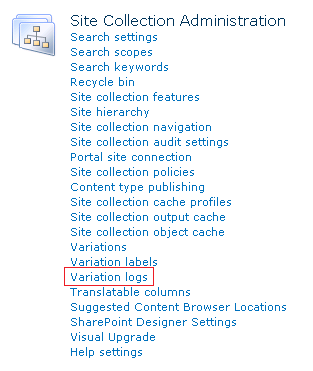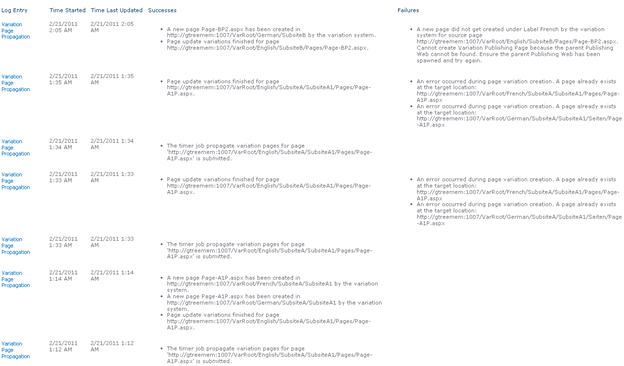Part 1 – The Basics
Part 2 – User Interface
Part 3 – Triggers
Part 4 – Timer Jobs
Part 5 – Configuration Overview
Part 6 – Configuration Internals
Part 7 – Variation Hierarchy Creation
Part 8 – Creating Page Variants
Part 9 – Creating Site Variants
Part 10 – Restructuring the Hierarchy
Part 11 – Variations Fixup Tool
Part 12 – Customization
Part 13 – Logging
Part 14 – Troubleshooting
Part 15 – “View Changes” Button
Part 16 – Translation Support
Part 17 – MOSS 2007 vs. SP 2010
Part 18 – FAQ
This part highlights the different logging options for the SharePoint variation system.
Variation Logs
The variation system logs status information into the hidden Long Running Operation Status list in the root of the site collection. Most problems related to variations are reflected in this log.
The Variation logs can be inspected through a link in the Site Collection Administration section of the Site Settings page:

The variation log uses a GridView control to display a filtered view of the Long Running Operation Status list using a SPDataSource control. The data source returns all rows from the Long Running Operation Status list where the Type Of Job column contains the string “Variation”. Newest entries are listed first.
Success messages and Failures are listed in separate columns, which give easy access to the information if a problem has occurred with recent propagations:

ULS Log
In case that the information in the Variation Log is not sufficient to isolate a variation problem, it is possible to leverage the SharePoint Unified Logging Service (ULS) to get additional logging information.
Both the Variations Infrastructure and the Content Deployment and Migration API (which is used to perform export and import operations during page propagation) use the ULS log to report problems using the following categories:
For the Content Deployment and Migration API:
- SharePoint Foundation\Content Migration
- SharePoint Foundation\Topology
For the Variations Feature:
- Web Content Management\Site Management
- Web Content Management\Publishing Provisioning
To troubleshoot, variation related issues these four categories should be set to Verbose in the central administration page.
You can use ULS Viewer to conveniently analyze ULS log files.
The most important category is Site Management. You should filter the ULS log for this category first. If this does not give you relevant information, add the other two WCM categories on top. If the problem is related to problems occurring during export/import, you need to add the two SharePoint Foundation categories as well.
